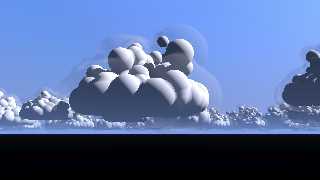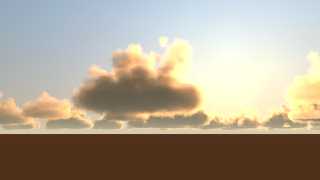 |
 |
|
 |
|
 |
|  |
|  |
|
 |
|
 |
|  |
|  |
|
 |
I was going to add some cumulus to my sea scene, but the ones I had from
the project tierra where not very convincing, so... I started another
experiment.
The approach is similar to that of my previous cumulus include, but with
a trick to make softer media. As the method involved the object pattern,
the media was a bit sharp with just 0 or 1 in the density map.
The trick is to create an array of blob components positions and radius,
then use that to create 4 blobs with concentric shapes and use them on
an averaged density map. The results are surprisingly fast... this one
took "only" 47 min.
--
jaime
Post a reply to this message
Attachments:
Download 'blob-clouds-test-03d.jpg' (52 KB)
Preview of image 'blob-clouds-test-03d.jpg'

|
 |
|  |
|  |
|
 |
|
 |
|  |
|  |
|
 |
Jaime Vives Piqueres <jai### [at] ignorancia org> wrote:
> The trick is to create an array of blob components positions and radius,
> then use that to create 4 blobs with concentric shapes and use them on
> an averaged density map. The results are surprisingly fast... this one
> took "only" 47 min.
Nice and fluffy as it should be.
The method of averaging object patterns will be of further use - at least I hope
so...
Norbert org> wrote:
> The trick is to create an array of blob components positions and radius,
> then use that to create 4 blobs with concentric shapes and use them on
> an averaged density map. The results are surprisingly fast... this one
> took "only" 47 min.
Nice and fluffy as it should be.
The method of averaging object patterns will be of further use - at least I hope
so...
Norbert
Post a reply to this message
|
 |
|  |
|  |
|
 |
|
 |
|  |
|  |
|
 |
Jaime Vives Piqueres <jai### [at] ignorancia org> wrote:
> I was going to add some cumulus to my sea scene, but the ones I had from
> the project tierra where not very convincing, so... I started another
> experiment.
>
> The approach is similar to that of my previous cumulus include, but with
> a trick to make softer media. As the method involved the object pattern,
> the media was a bit sharp with just 0 or 1 in the density map.
>
> The trick is to create an array of blob components positions and radius,
> then use that to create 4 blobs with concentric shapes and use them on
> an averaged density map. The results are surprisingly fast... this one
> took "only" 47 min.
>
> --
> jaime
Here is a resource about the simulation on cloud phenomenon which I know.
http://wiki.flightgear.org/Atmospheric_light_scattering org> wrote:
> I was going to add some cumulus to my sea scene, but the ones I had from
> the project tierra where not very convincing, so... I started another
> experiment.
>
> The approach is similar to that of my previous cumulus include, but with
> a trick to make softer media. As the method involved the object pattern,
> the media was a bit sharp with just 0 or 1 in the density map.
>
> The trick is to create an array of blob components positions and radius,
> then use that to create 4 blobs with concentric shapes and use them on
> an averaged density map. The results are surprisingly fast... this one
> took "only" 47 min.
>
> --
> jaime
Here is a resource about the simulation on cloud phenomenon which I know.
http://wiki.flightgear.org/Atmospheric_light_scattering
Post a reply to this message
|
 |
|  |
|  |
|
 |
|
 |
|  |
|  |
|
 |
On 04/26/2016 08:47 AM, Jaime Vives Piqueres wrote:
> I was going to add some cumulus to my sea scene, but the ones I had from
> the project tierra where not very convincing, so... I started another
> experiment.
>
> The approach is similar to that of my previous cumulus include, but with
> a trick to make softer media. As the method involved the object pattern,
> the media was a bit sharp with just 0 or 1 in the density map.
>
> The trick is to create an array of blob components positions and radius,
> then use that to create 4 blobs with concentric shapes and use them on
> an averaged density map. The results are surprisingly fast... this one
> took "only" 47 min.
>
> --
> jaime
>
Impressive - though am I correct there are some artifacts in the right
part of the center top plume? Was it run with AA ?
Asking mostly because of my continuing look into blob related bugs.Those
spots look like other issues I have seen related to media and blobs at
the blob(s) boundary.
Bill P.
Post a reply to this message
|
 |
|  |
|  |
|
 |
|
 |
|  |
|  |
|
 |
> Nice and fluffy as it should be.
Thanks... perhaps too fluffy, tough.
> The method of averaging object patterns will be of further use - at least I hope
> so...
Well, it's nothing fancy, just the average pattern. The real trick is
that the averaged blobs are concentric (with diminishing radius and the
same threshold):
interior{
media{
method 3 intervals 1 samples Cloud_Samples
scattering{2,.01}
absorption .005
density{
average
density_map{
[1
object{
cloud_a
color rgb 0
color rgb .25
}
warp{turbulence .5}
scale 2 warp{turbulence .67} scale 1/2
scale 4 warp{turbulence 1} scale 1/4
]
[1
object{
cloud_b
color rgb 0
color rgb .5
}
warp{turbulence .5}
scale 2 warp{turbulence .67} scale 1/2
]
[1
object{
cloud_c
color rgb 0
color rgb .75
}
warp{turbulence .5}
]
[1
object{
cloud_d
color rgb 0
color rgb 1
}
warp{turbulence .5}
]
}
}
}
}
--
jaime
Post a reply to this message
|
 |
|  |
|  |
|
 |
|
 |
|  |
|  |
|
 |
> Here is a resource about the simulation on cloud phenomenon which I
> know.
>
> http://wiki.flightgear.org/Atmospheric_light_scattering
Well, fortunately POV-Ray media scattering type 2 takes care of all
that... what I'm really looking for is some method to create convincing
cumulus shapes. Right now they are just a bunch of blob spheres filling
a random conical shape, but I've got some ideas to try from this paper:
https://hal.inria.fr/inria-00537462/file/BN04_clouds.pdf
I will try to start with a base blob with just a few big components
and then trace a lot of smaller ones on the surface of it.
--
jaime
Post a reply to this message
|
 |
|  |
|  |
|
 |
|
 |
|  |
|  |
|
 |
El 26/04/16 a las 15:52, William F Pokorny escribió:
> Impressive - though am I correct there are some artifacts in the
> right part of the center top plume? Was it run with AA ?
You have a good eye... I had to zoom several times to see them! Yes,
it was run without AA, and the artifacts are likely due to the media
container (another blob, BTW... I forgot to mention this).
> Asking mostly because of my continuing look into blob related
> bugs.Those spots look like other issues I have seen related to media
> and blobs at the blob(s) boundary.
Yes, that's likely the problem: see the attached test. The inner solid
blob is the object used on the density pattern, and the transparent
outer blob is the media container: you can clearly see the artifacts are
coincident with a blob boundary.
--
jaime
Post a reply to this message
Attachments:
Download 'blob-clouds-test-03d-containers.jpg' (74 KB)
Preview of image 'blob-clouds-test-03d-containers.jpg'

|
 |
|  |
|  |
|
 |
|
 |
|  |
|  |
|
 |
Another one using the exact same clouds but with a sunset lighting.
--
jaime
Post a reply to this message
Attachments:
Download 'blob-clouds-test-03e.jpg' (49 KB)
Preview of image 'blob-clouds-test-03e.jpg'

|
 |
|  |
|  |
|
 |
|
 |
|  |
|  |
|
 |
Jaime Vives Piqueres <jai### [at] ignorancia org> wrote:
> > Nice and fluffy as it should be.
>
> Thanks... perhaps too fluffy, tough.
>
> > The method of averaging object patterns will be of further use - at least I hope
> > so...
>
> Well, it's nothing fancy, just the average pattern. The real trick is
> that the averaged blobs are concentric (with diminishing radius and the
> same threshold):
>
>
> interior{
> media{
> method 3 intervals 1 samples Cloud_Samples
> scattering{2,.01}
> absorption .005
> density{
> average
> density_map{
> [1
> object{
> cloud_a
> color rgb 0
> color rgb .25
> }
> warp{turbulence .5}
> scale 2 warp{turbulence .67} scale 1/2
> scale 4 warp{turbulence 1} scale 1/4
> ]
> [1
> object{
> cloud_b
> color rgb 0
> color rgb .5
> }
> warp{turbulence .5}
> scale 2 warp{turbulence .67} scale 1/2
> ]
> [1
> object{
> cloud_c
> color rgb 0
> color rgb .75
> }
> warp{turbulence .5}
> ]
> [1
> object{
> cloud_d
> color rgb 0
> color rgb 1
> }
> warp{turbulence .5}
> ]
> }
> }
> }
> }
>
> --
> jaime
Thank you for the code snippet.
Concentric is clear, otherwise it would be similar to proximity patterns.
But, who knows...
Norbert org> wrote:
> > Nice and fluffy as it should be.
>
> Thanks... perhaps too fluffy, tough.
>
> > The method of averaging object patterns will be of further use - at least I hope
> > so...
>
> Well, it's nothing fancy, just the average pattern. The real trick is
> that the averaged blobs are concentric (with diminishing radius and the
> same threshold):
>
>
> interior{
> media{
> method 3 intervals 1 samples Cloud_Samples
> scattering{2,.01}
> absorption .005
> density{
> average
> density_map{
> [1
> object{
> cloud_a
> color rgb 0
> color rgb .25
> }
> warp{turbulence .5}
> scale 2 warp{turbulence .67} scale 1/2
> scale 4 warp{turbulence 1} scale 1/4
> ]
> [1
> object{
> cloud_b
> color rgb 0
> color rgb .5
> }
> warp{turbulence .5}
> scale 2 warp{turbulence .67} scale 1/2
> ]
> [1
> object{
> cloud_c
> color rgb 0
> color rgb .75
> }
> warp{turbulence .5}
> ]
> [1
> object{
> cloud_d
> color rgb 0
> color rgb 1
> }
> warp{turbulence .5}
> ]
> }
> }
> }
> }
>
> --
> jaime
Thank you for the code snippet.
Concentric is clear, otherwise it would be similar to proximity patterns.
But, who knows...
Norbert
Post a reply to this message
|
 |
|  |
|  |
|
 |
|
 |
|  |
|  |
|
 |
Am 26.04.2016 um 18:58 schrieb Jaime Vives Piqueres:
> Another one using the exact same clouds but with a sunset lighting.
You folks are amazing!
Post a reply to this message
|
 |
|  |
|  |
|
 |
|
 |
|  |




![]()